
The southern French city of Toulouse is probably best known as the gateway to the Canal du Midi, a canal built under orders from Sun King Louis XIV back in the 1600s to connect the Mediterranean Sea with the Atlantic Ocean, and it is a popular place for hopping onto a narrow houseboat for a bit of slow boating. The city’s other claims to fame are its aviation history and the fact that many of its ancient houses have been built from an orange-pink stone, earning it the moniker La Ville Rose, the Pink City.
Videos by TravelAwaits
The capital of the Occitanie region and close to the Pyrenees mountain range, Toulouse’s ancient cobbled streets are signposted in two languages: French and Occitan, a language that sounds like a cross between French, Italian, and Spanish. But despite it being France’s fourth-largest city with 1.2 million inhabitants, the center of the city is intrinsically walkable, making it perfect for a day of exploration, although if you decided on staying longer, you would not get bored either.

Exploring The Pink Heart Of Toulouse
Setting off from the rather grand Place Capitole, head down Rue Lafayette toward Metro Capitole, with the Tourism Office located in the cute turret in the park on your left. From here on, head roughly along the large pedestrianized shopping street that is Rue d’ Alsace Lorraine, which turns into Rue du Languedoc.
Of course, is just a general guide, as the most picturesque areas are the little streets and squares, such as Place St Georges and Square de la Trinite by rue des Filatiers along the way, and off to both sides. Rue des Arts and Pierre de Fermat, together with Rue Peyas and Rue des Changes, are all pedestrianized and invite you to get lost and explore. Closer to Place Capitole, must-sees are rue du Taur and the Victor Hugo Market. On your way, look out for the fabulous churches of Basilique Saint-Sernin and Notre-Dame du Taur, both with spectacular steeples, and the Jacobines Convent and the Musee des Augustines for impressive medieval architecture.
But more to the point, look at all the crooked, pink buildings in the cobble-stoned alleyways, and you’ll soon understand why Toulouse is called the Pink City.
Discovering The Arts In Toulouse
It feels like art is all around you when exploring Toulouse, be it the stunning street art in and around Rue Gramat in the quartier Arnaud-Bernard, the small architectural details on the buildings, or the modern Victor Hugo market building at the corner of Rue Causette and Rue du Rempart Villeneuve, where styles contrast, but beautifully so. But for a proper art fix, look no further than the Fondation Bemberg housed in a gorgeous city palace, the Hotel d’Assezat. Crammed full of anything and everything from achingly beautiful Canalettos to delicate blue-and-white ceramics, all in sumptuous surroundings, this is a favorite art museum in Toulouse that will take up at least an hour of your time.
For a more contemporary approach, don’t miss Les Abattoirs. Yes, the sprawling complex once housed abattoirs (that is, slaughterhouses), but is now completely re-invented and a one-stop-shop for indoor and outdoor contemporary art in an equally, if totally different, setting than the old palace. Plus, there is a great cafe. Depending on the exhibitions and when you visit, plan on between an hour and two hours spent here.

Take Flight In Toulouse
Toulouse’s aviation history is one of firsts, from the first motorized plane built in Toulouse and the first European postal service Aeropostale launched with pilot-turned-author Saint-Exupery and legendary Jean Mermoz as pilots to the first supersonic plane, the Concorde, built and tested in Toulouse, and the first double-decker passenger plane, the A380, that was assembled and first flown in Toulouse. Add to that the country’s space research and, quite literally, rocket science centers situated here as well, and if you are not an aviation enthusiast to start with, Toulouse will turn you into one.
To experience some of the city’s aviation buzz, go west on metro line B to Ramonville and then onto Bus 37 to the Cite de l’Espace, where you can have a look at the MIR space station and finally figure out how the bathrooms work in space, then walk along the Piste des Geants, the former runway the first international postal flights took off from.
Or head north-east to Aeroscopia on Tram line T1 from metro stop Arenes to witness a collection of some of the world’s largest, fastest, oldest, and simply most amazing aircraft. You can also pop across to one of the enormous hangars to see some of the Airbus A380 assembly stages.
Sadly, both options are a little out of the city center, and you would have to allow a three-hour round trip for each, so choose wisely!

Watch The Sunset With An Aperitif In Hand
The mighty Garonne River curves through Toulouse on its way toward Bordeaux and eventually the Atlantic Ocean. One of a handful of worldwide rivers that experience a tidal bore, it is also the only place left where the critically endangered European sea sturgeon still breed. The river is crossed by many bridges, but the loveliest is Pont Neuf, officially opened by Louis XIV on October 19, 1659 after nearly a century of building in progress.
In time for sunset, it is a lovely walk under the trees. Look at the river and head toward Quai de la Daurade. By the quay, there are plenty of benches and grassy areas all awaiting the nightly influx of locals and visitors alike, headed there for a spectacular sunset over the river and against the Toulouse skyline. Head to the terrace of the Cafe des Artists, order an aperitif, and wait for the sun to set. And while the sun is turning your surroundings orange and pink, the starlings of the area will usually turn up for a chirpy murmuration before settling down for the night in the trees. It is a perfect spot to wind down from the day, and for relaxing before heading to a good Toulouse dinner.

Eating In Toulouse
Eating in Toulouse, as in the rest of France, is important. Many small restaurants offer traditional Toulouse food, such as hearty cassoulets, a bean-and-sausage stew, but there are also plenty of lighter options around. For breakfast, simply grab a fresh croissant from any boulangerie and a coffee on the go and settle in a park for a morning picnic.
While you are exploring the city, pop into Boca (45 Rue Peyrolieres) for a light lunch. Their fresh baguette sandwiches and tapas, such as gorgeous Spanish omelet tortillas, are perfect.
For a sweet treat in between meals, look no further than Le Bonbonniere , where you get a selection of cakes and sweets traditional in Toulouse.
In the evening, head back to Victor Hugo Market and sit outside like the locals. J’Go offers a good cassoulet and many daily specials from fish to meat fresh from the market. They also have a great selection of wines.
Where To Stay In Toulouse
If you want luxury right in the middle of it all, look no further than the Grand Hotel de l’Opera, right on Place Capitole in the city center. The grand building is full of great design details and is perfect for that first-class experience.
A little quieter but within a three-minute walk of the city center and set away from the street in a green courtyard, you’ll find Privilege Hotel Mermoz keeping with Toulouse’s aviation theme. A cozy bar, a quiet pool, and lovely staff make it a haven away from the bustle of the city.
Or, for a legendary stay, book room 32 in the Grand Balcon Hotel, where Saint Exupéry lived and wrote for an extended period. Comfortable, overlooking the Place Capitole, and right on the corner of some of Toulouse’s best historic streets, this is a literary stay right in the city center.

The Toulouse 24-Hour Tourism Pass
The tourism office by metro Capitol is the place to buy a 24-hour Tourism Pass, which allows you free entrance to the below-mentioned art museums, free public transport, and reduced access to the aviation attractions. For €18 per person, it is worth it if you decide to pop into several museums and maybe hop onto the metro a few times, but not if you are mostly interested in walking and looking.
The entrance fees in Toulouse are relatively low. For example, the full entrance fee to Fondation Bemberg is €8 per person, and the pass’s 15 percent reduction at the Cite de l’ Espace or a €2.50 reduction at Aeroscopia only just make it worth it. But if you intend to pop into other museums along the way, then get the card, as it will save you a few euros and a bit of hassle throughout the day. And, if using public transport, please remember to validate the card on the machines inside the bus, tram, or metro; otherwise you will be charged a fine.
Find more information on the 24-hour tourism pass here.
Planning the ultimate French vacation? Read up on our suggested driving tour of the south of France: six destinations to visit, plus nine tips for visiting France’s Mont-Saint-Michel.
